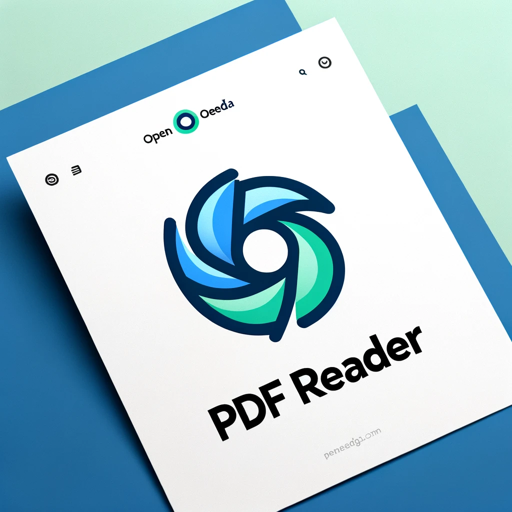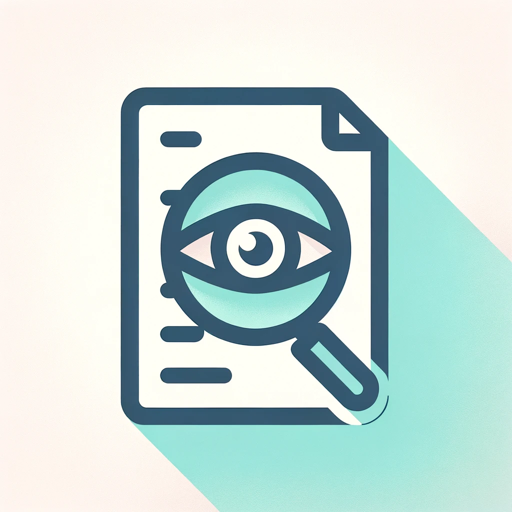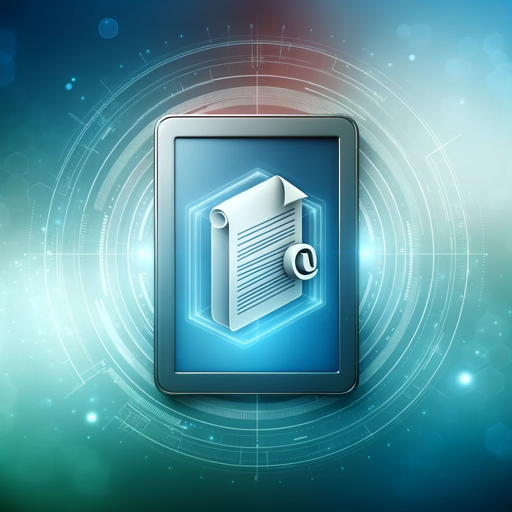Journal Recognizer OCR-AI OCR tool for transcribing printed text from images, preserving formatting and offering easy customization for academic, research, and document digitization needs.
AI-powered OCR for seamless text transcription.
Optimized OCR for Handwritten Notebooks, up to 10 image transcript copy w/1-click. No text prompt necessary. Reads journals, reports, notes. All handwriting transcribed verbatim, then text summarized, graphic image features described. Ask to change any b
Transcribe this set of images into text (default behavior)
Describe the graphics in this image and their relation to the text [inside square brackets] (default behavior)
Adjust the focus on graphic elements in this image transcription.
By default images entered will be searched first for handwritten text, then printed text.
Summarize the content from these images without transcribing.
Attach images, no text prompt necessary for default behavior (transcript in a block)
Related Tools

PDF Reader
In-depth interaction with PDF content

OCR
Extract text and content from images or PDF documents

OCR with GPT Vision
VisionText Extractor GPT is designed to perform Optical Character Recognition (OCR) on uploaded images, extracting text with precision.

ChatDOC
Boost your research with ChatDOC! From research paper to financial reports, you can chat with single / multiple files, let AI summarize long documents, explain complex concepts, and find key information in seconds.
OCR: PDF- and image-reader
Provides tekst from images and scanned documents by using optical character recognition (OCR)

OCR (formerly ChatOCR)
Extract text from scanned PDFs, photos, and even handwriting.
20.0 / 5 (200 votes)
Introduction to Journal Recognizer OCR
Journal Recognizer OCR is a specialized tool designed for the seamless transcription of text from images into structured, accessible plain text. The primary focus is on ensuring that users can easily extract and consolidate text from various types of images, including scanned documents, journal pages, and other forms of printed or handwritten content. The tool is built to handle complex layouts, preserve paragraph integrity, and offer additional context through graphic element analysis. For instance, when provided with a series of images containing journal entries, Journal Recognizer OCR would transcribe the text into a single, continuous code block, maintaining the original flow and highlighting significant graphical elements such as illustrations or diagrams. This makes it particularly useful for researchers, archivists, and professionals who need to digitize and analyze large volumes of printed material.

Core Functions of Journal Recognizer OCR
Single Code Block Consolidation
Example
A researcher scans several pages from an old journal and uploads the images. Journal Recognizer OCR transcribes the text from all the images into one continuous block of text, enabling easy copying and editing.
Scenario
This function is crucial when working with multiple-page documents where maintaining the flow of information is important. It prevents the need for manual text compilation and reduces the risk of errors.
Continuous Paragraph Formatting
Example
An academic needs to transcribe a manuscript where paragraphs span across multiple pages. Journal Recognizer OCR preserves the paragraph structure across images, ensuring that the text remains true to the original layout.
Scenario
This is particularly useful for historical document preservation, where maintaining the integrity of the text's structure is vital for accurate interpretation.
Graphic Element Handling
Example
A user uploads images of a textbook with various diagrams. Journal Recognizer OCR identifies and describes these diagrams, embedding the descriptions within the transcribed text at the relevant locations.
Scenario
This function benefits users who need a comprehensive understanding of both the text and associated visual elements, such as educators preparing digital teaching materials.
Ideal Users of Journal Recognizer OCR
Researchers and Academics
Researchers dealing with large volumes of historical documents, manuscripts, or academic journals benefit from Journal Recognizer OCR's ability to consolidate and format text accurately. The tool's attention to detail in preserving paragraph structure and integrating graphic elements makes it invaluable for creating digital archives or preparing texts for analysis.
Archivists and Librarians
Archivists and librarians who manage collections of printed materials can use Journal Recognizer OCR to digitize these resources efficiently. The tool's ability to handle complex layouts and transcribe text with high accuracy ensures that valuable information is preserved and made accessible for future use.

How to Use Journal Recognizer OCR
Visit aichatonline.org for a free trial without login, also no need for ChatGPT Plus.
Start by visiting the AI Chat Online website, where you can access Journal Recognizer OCR for free, no login or subscription required.
Upload or provide the images.
Prepare the images containing the text you want to transcribe. Upload these images directly through the interface provided on the website.
Specify your desired output format.
Choose the output format for the text, including options like plain text or markdown with basic style information. Select any specific settings such as letter-perfect transcription or continuous paragraph formatting.
Review and customize the output.
Once the text is transcribed, review it for accuracy. You can edit or customize the text directly within the tool, ensuring it meets your needs before finalizing.
Download or copy the transcribed text.
After reviewing, you can easily download the text or copy it to your clipboard for use in your documents, projects, or any other application.
Try other advanced and practical GPTs
Revenue-driven SEO keyword research and analysis
AI-driven keywords for traffic and sales

Resume Builder
AI-Powered Tool for Perfect Resumes

GPT Builder Builder
Customize AI to Fit Your Needs.
10x Developer
AI-powered solutions for complex coding challenges

Ambition
AI-powered job search and application enhancement
Sticker Creator
AI-powered stickers from your photos

SEObot
Optimize your website with AI-driven SEO.

Music Creator ⭐ ⭐ ⭐ ⭐ ⭐
AI-powered music creation made simple.

Podcast Pro
AI-powered podcast production, simplified.

Gif_Animator
AI-Powered GIF Creation Tool

Comic Crafter
AI-powered tool for effortless comic creation.

Career Coach
AI-driven insights for your career success

- Academic Writing
- Data Extraction
- Document Digitization
- Research Transcription
- Journal Scanning
Common Questions About Journal Recognizer OCR
What types of text can Journal Recognizer OCR transcribe?
Journal Recognizer OCR can transcribe a wide range of printed text from images, including paragraphs, headings, and even stylized text with basic formatting. It is designed to capture the flow of the original document, making it ideal for academic papers, journal articles, and more.
Does Journal Recognizer OCR support handwritten text?
Currently, Journal Recognizer OCR is optimized for printed text. While it may recognize some handwritten text, the accuracy is not guaranteed. It works best with clear, printed text from scanned documents or images.
Can I use Journal Recognizer OCR for free?
Yes, you can use Journal Recognizer OCR for free on the AI Chat Online website. There's no need for a login or a paid subscription, making it accessible to anyone who needs high-quality OCR services.
How does Journal Recognizer OCR handle formatting?
Journal Recognizer OCR can preserve basic formatting elements such as paragraphs and headings in markdown format. This helps maintain the structure of the original document, making it easier to use in your own work.
Is Journal Recognizer OCR suitable for academic use?
Yes, Journal Recognizer OCR is particularly well-suited for academic use, where maintaining the integrity of transcribed text from journals, articles, and research papers is crucial. It supports continuous paragraph formatting, making it ideal for academic writing and research.